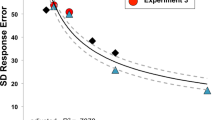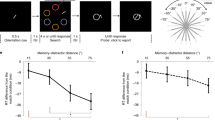Abstract
The capacity of visual short-term memory is highly limited, maintaining only three to four objects simultaneously1,2. This extreme limitation necessitates efficient mechanisms to select only the most relevant objects from the immediate environment to be represented in memory and to restrict irrelevant items from consuming capacity3,4,5. Here we report a neurophysiological measure of this memory selection mechanism in humans that gauges an individual's efficiency at excluding irrelevant items from being stored in memory. By examining the moment-by-moment contents of visual memory6, we observe that selection efficiency varies substantially across individuals and is strongly predicted by the particular memory capacity of each person. Specifically, high capacity individuals are much more efficient at representing only the relevant items than are low capacity individuals, who inefficiently encode and maintain information about the irrelevant items present in the display. These results provide evidence that under many circumstances low capacity individuals may actually store more information in memory than high capacity individuals. Indeed, this ancillary allocation of memory capacity to irrelevant objects may be a primary source of putative differences in overall storage capacity.
This is a preview of subscription content, access via your institution
Access options
Subscribe to this journal
Receive 51 print issues and online access
$199.00 per year
only $3.90 per issue
Buy this article
- Purchase on Springer Link
- Instant access to full article PDF
Prices may be subject to local taxes which are calculated during checkout



Similar content being viewed by others
References
Luck, S. J. & Vogel, E. K. The capacity of visual working memory for features and conjunctions. Nature 390, 279–281 (1997)
Sperling, G. The information available in brief visual presentations. Psychol. Monogr. 74, Whole No. 498 (1960)
Rainer, G., Asaad, W. F. & Miller, E. K. Selective representation of relevant information by neurons in the primate prefrontal cortex. Nature 393, 577–579 (1998)
Bundesen, C., Pedersen, L. F. & Larsen, A. Measuring efficiency of selection from briefly exposed visual displays: a model for partial report. J. Exp. Psychol. Hum. Percept. Perform. 10, 329–339 (1984)
Kane, M. J. & Engle, R. W. Working memory capacity and the control of attention: the contributions of goal neglect, response competition, and task set to Stroop interference. J. Exp. Psychol. Gen. 132, 47–70 (2003)
Vogel, E. K. & Machizawa, M. G. Neural activity predicts individual differences in visual working memory capacity. Nature 428, 748–751 (2004)
Vogel, E. K., Woodman, G. F. & Luck, S. J. Storage of features, conjunctions, and objects in visual working memory. J. Exp. Psychol. Hum. Percept. Perform. 27, 92–114 (2001)
Cowan, N. The magical number 4 in short-term memory: a reconsideration of mental storage capacity. Behav. Brain Sci. 24, 87–185 (2001)
Pashler, H. Familiarity and visual change detection. Percept. Psychophys. 44, 369–378 (1988)
Rypma, B. & D'Esposito, M. D. The influence of working memory demand and subject performance on prefrontal cortical activity. J. Cogn. Neurosci. 14, 721–731 (2002)
Rypma, B. & D'Esposito, M. D. Isolating the neural mechanisms of age-related changes in human working memory. Nature Neurosci. 3, 509–515 (2000)
Gale, A. & Edwards, J. in Psychophysiology: Systems, Processes, and Applications (eds Coles, M., Donchin, E. & Porges, S. W.) 431–486 (Guilford, New York, 1986)
Shih, S. & Sperling, G. Is there feature-based attentional selection in visual search? J. Exp. Psychol. Hum. Percept. Perform. 22, 758–779 (1996)
Anllo-Vento, L. & Hillyard, S. A. Selective attention to the colour and direction of moving stimuli: Electrophysiological correlates of hierarchical feature selection. Percept. Psychophys. 58, 191–206 (1996)
Woodman, G. F. & Vogel, E. K. Fractionating visual working memory: encoding and maintenance are independent processes. Psychol. Sci. 16, 106–113 (2005)
Jiang, Y. & Kumar, A. Visual short-term memory for two sequential arrays: one representation or two representations? Psychonomic Bull. Rev. 11, 495–500 (2004)
Miller, E. K., Erickson, C. A. & Desimone, R. Neural mechanisms of visual working memory in prefrontal cortex of the macaque. J. Neurosci. 16, 5154–5167 (1996)
Everling, S., Tinsley, C. J., Gaffan, D. & Duncan, J. Filtering of neural signals by focused attention in the monkey prefrontal cortex. Nature Neurosci. 5, 671–676 (2002)
Desimone, R. & Duncan, J. Neural mechanisms of selective visual attention. Annu. Rev. Neurosci. 18, 193–222 (1995)
Miller, E. K. & Cohen, J. D. An integrative theory of prefrontal cortex function. Annu. Rev. Neurosci. 24, 167–202 (2001)
Duncan, J. et al. A neural basis for general intelligence. Science 289, 457–460 (2000)
Gray, J. R., Chabris, C. & Braver, T. S. Neural mechanisms of general fluid intelligence. Nature Neurosci. 6, 316–322 (2003)
Engle, R. W., Kane, M. J. & Tuholski, S. W. in Models of Working Memory: Mechanisms of Active Maintenance and Executive Control (eds Miyake, A. & Shah, P.) 102–134 (Cambridge Univ. Press, New York, 1999)
Vogel, E. K., Luck, S. J. & Shapiro, K. L. Electrophysiological evidence for a postperceptual locus of suppression during the attentional blink. J. Exp. Psychol. Hum. Percept. Perform. 24, 1656–1674 (1998)
Acknowledgements
This work was supported by grants from the US National Institute of Mental Health and the Oregon Medical Research Foundation.
Author information
Authors and Affiliations
Corresponding author
Ethics declarations
Competing interests
Reprints and permissions information is available at npg.nature.com/reprintsandpermissions. The authors declare no competing financial interests.
Rights and permissions
About this article
Cite this article
Vogel, E., McCollough, A. & Machizawa, M. Neural measures reveal individual differences in controlling access to working memory. Nature 438, 500–503 (2005). https://doi.org/10.1038/nature04171
Received:
Accepted:
Issue Date:
DOI: https://doi.org/10.1038/nature04171
This article is cited by
-
Visual perceptual load and processing of somatosensory stimuli in primary and secondary somatosensory cortices
Scientific Reports (2023)
-
Stimulus specific cortical activity associated with ignoring distraction during working memory encoding and maintenance
Scientific Reports (2023)
-
Effects of temporal order and relative location on distractor interference in visual working memory
Current Psychology (2023)
-
Using clustering algorithms to examine the association between working memory training trajectories and therapeutic outcomes among psychiatric and healthy populations
Psychological Research (2023)
-
The Imbalance of Wanting and Liking Contributes to a Bias of Internal Attention Towards Positive Consequences of Tobacco Smoking
International Journal of Mental Health and Addiction (2023)
Comments
By submitting a comment you agree to abide by our Terms and Community Guidelines. If you find something abusive or that does not comply with our terms or guidelines please flag it as inappropriate.



